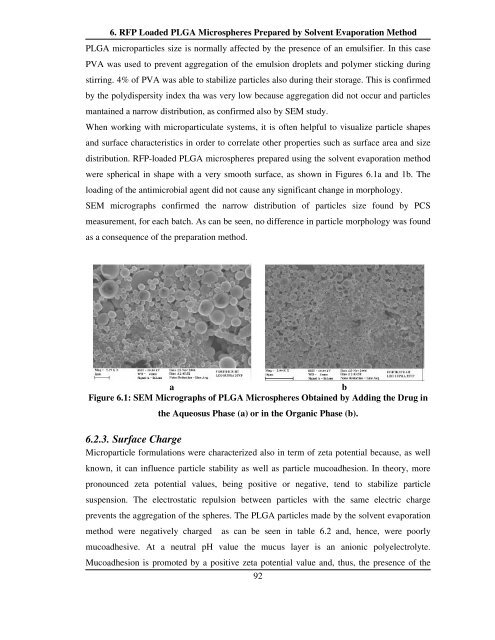chitosan and plga microspheres as drug delivery ... - UniCA Eprints
chitosan and plga microspheres as drug delivery ... - UniCA Eprints
chitosan and plga microspheres as drug delivery ... - UniCA Eprints
You also want an ePaper? Increase the reach of your titles
YUMPU automatically turns print PDFs into web optimized ePapers that Google loves.
6. RFP Loaded PLGA Microspheres Prepared by Solvent Evaporation MethodPLGA microparticles size is normally affected by the presence of an emulsifier. In this c<strong>as</strong>ePVA w<strong>as</strong> used to prevent aggregation of the emulsion droplets <strong>and</strong> polymer sticking duringstirring. 4% of PVA w<strong>as</strong> able to stabilize particles also during their storage. This is confirmedby the polydispersity index tha w<strong>as</strong> very low because aggregation did not occur <strong>and</strong> particlesmantained a narrow distribution, <strong>as</strong> confirmed also by SEM study.When working with microparticulate systems, it is often helpful to visualize particle shapes<strong>and</strong> surface characteristics in order to correlate other properties such <strong>as</strong> surface area <strong>and</strong> sizedistribution. RFP-loaded PLGA <strong>microspheres</strong> prepared using the solvent evaporation methodwere spherical in shape with a very smooth surface, <strong>as</strong> shown in Figures 6.1a <strong>and</strong> 1b. Theloading of the antimicrobial agent did not cause any significant change in morphology.SEM micrographs confirmed the narrow distribution of particles size found by PCSme<strong>as</strong>urement, for each batch. As can be seen, no difference in particle morphology w<strong>as</strong> found<strong>as</strong> a consequence of the preparation method.abFigure 6.1: SEM Micrographs of PLGA Microspheres Obtained by Adding the Drug inthe Aqueosus Ph<strong>as</strong>e (a) or in the Organic Ph<strong>as</strong>e (b).6.2.3. Surface ChargeMicroparticle formulations were characterized also in term of zeta potential because, <strong>as</strong> wellknown, it can influence particle stability <strong>as</strong> well <strong>as</strong> particle mucoadhesion. In theory, morepronounced zeta potential values, being positive or negative, tend to stabilize particlesuspension. The electrostatic repulsion between particles with the same electric chargeprevents the aggregation of the spheres. The PLGA particles made by the solvent evaporationmethod were negatively charged<strong>as</strong> can be seen in table 6.2 <strong>and</strong>, hence, were poorlymucoadhesive. At a neutral pH value the mucus layer is an anionic polyelectrolyte.Mucoadhesion is promoted by a positive zeta potential value <strong>and</strong>, thus, the presence of the92
















